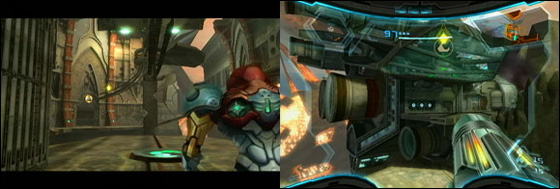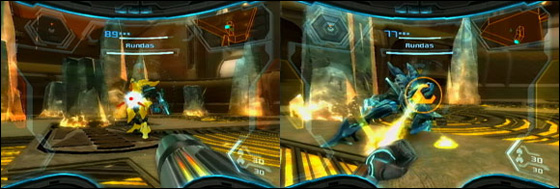Metroid Prime 3: Quarterly Diaries #2
October 1st, 2009

Areas Covered: Cliffside Airdock, Firey Airdock
Discussion Points: Phazon subtext, Bryyo level design, Half-life 2 comparison, backtracking, environment design, Rundas boss battle
Ok, it looks like this series of posts won’t be all that quarterly, but that’s okay. Last time I discussed Metroid Prime 3‘s opening tutorial levels on Olympus and Norion. After being flanked by Meta Ridley and Dark Samus, Samus awakens back on Olympus equipped with the new PED suit, setting out for Bryyo. This post shall concentrate on the Bryyo portion of the game.
Bryyo – Cliffside Airdock
The pragmatic purposes of hyper mode from the newly-acquired PED suit require no real explanation; it’s a new feature implanted into Samus’ suit which allows for a temporal power overload by delivering rapid boosts of Phazon. There’s a subtext here. With the substance now integrated into her suit and utilized freely, Samus and the federation (see: PED-suited soldiers), like the pirates before them, are resorting to Phazon in order to hold their ground in the continual power struggle. The trilogy has slowly edged towards a more accommodating view of Phazon. What was once feared in Metroid Prime and Metroid Prime 2 as a dangerously potent catalyst is now a natural resource; a product of necessity. The good guys have struck a deal with the devil and with Phazon comes Dark Samus; it’s by this association that you know the narrative is going to soon smack into calamity.
As a gameplay device, hyper mode only makes its presence noticed about 4/5ths of the way through Bryyo. It’s a superfluous room clearer in the meantime, which is all well and good, really, because it takes a back suit to the fact that…
…Bryyo as a whole is very well designed. To be honest, I immediately lost wind of of the objectives handed to me and just became consumed by the process of following the rhythmic flow of progression, flagging relevant points of interest for my eventual return. The series has this uncanny ability to immerse the player into its world by designing around the player’s inner psyche. You rarely have to think your way through a Metroid game, progression just comes naturally because clues are put in logical – yet never obvious – places. The scan visor, of course, aids heavily in this process but never feels like cheating, it’s just part of the exploration process. People have made the same commentaries about the recent Batman: Arkham Asylum. The cohesion of the scan visor, play-centred level design and natural-earth aesthetic elicit Metroid’s strongest emotional trigger, being the feeling of unaided realization and discovery of the environment around you. The series, right from start up throws the player into this highly rhythmic mental slumber. In regards to Bryyo, I lapsed into this state (hardcore) for the first time in Metroid Prime 3 in Bryyo, conjuring up those feelings of previous games. Retro Studios don’t let up.

The most fascinating thing about the free form exploration is that it’s all intentional. You might feel like a genius for discovering some secret cavern at the back of the level, but the reality is, you were always meant to find it – that’s how they designed the game.
(Contrast this to the Half-life series which at times does a bloody awful job at stringing the player along. As I mentioned in my previous posts, the episodes did better, but playing Metroid Prime 3 only reasserts how poor the player guiding in the Half-life games truly were. Either game still has nothing on Super Metroid which flourishes astoundingly in this regard. On the other hand, the Metroid level design is constricted in contrast to Half-life‘s selection of open expanses. This changes the dynamic – maybe I shouldn’t make the comparison.)
The centre piece of the Cliffside Airdock area (Gateway) is a great example of this design. It’s a multidirectional entranceway, where, of course, there is only one linear path, but because the branched paths are blocked in such a seemingly natural way (ice blockages, wide abysses, falled debris; they really just disguise the fact that you don’t have X progressional power-up yet) it never feels closed off, just unattainable for the meantime.
The first weapon upgrade for this area is the grapple beam. It’s a nice choice to offer early on as the highly mobile swinging mechanic plays into the new-found fluidity in controls. After attaining it you head back to the Gateway area, follow the next stream of corridors, which you couldn’t previously access without the grapple beam, complete an objective, backtrack to the ship and then fly to the next area.
Firey Airdock
The course of the next area (Firey Airdock) adopts the same travel path; penetrate the level as far as possible, acquire new power-up (in this case the ice beam), backtrack to ship, fly to back to the other area, with aid of new power-up mine a little further, go back and do it all again. In fact, this formula is pasted throughout the entire Bryyo area, occasionally interluded by convenient landing zones for your ship. Ultimately then the same amount of backtracking as prior games ensues, albeit in smaller doses. Doesn’t this demean the convenience of the segregated areas preventing excessive amounts of backtracking? The ship does alleviate a good deal of backtracking, true, yet Retro, at least in Bryyo, don’t treat each section as a single chunk of gameplay, rather they’re a series of islands which must be mined back and forth. It’ll be interesting to observe if the other planets are designed in this manner too.

In contrast to the (Cliffside Airdock area’s) similarities with the Aether overworld from Metroid Prime 2, the visual theme of the Firey Airdock area is akin to Magmoor Caverns from Metroid Prime. Pleasantly though, either locale never feels borrowed, derived or too familiar. The Cliffside Airdock area music doesn’t have the thunderous presence of its forebearer, rather it’s a historically lived-in site with signs of cultural prestige and social functionality. The Firey Airdock area is more industrious than Magmoor Mines with elaborate mechanical puzzles operated by a volatile, yellow jelly.
By this stage Retro have well warmed the seat for the player. The puzzles and level design are instinctive and easily on par with the rest of the series, only aided by the fluidity of the controls. The controls, mixed with the streamlining (such as flicking through visors and only having one beam) remove the baggage of the previous games and allow the player to freely dive into business. Further examples of the clever interfacing are seen in the landing site puzzles up ahead.
I ought to talk about the Rundas boss battle first though. I found this confrontation to be rather awkward. Three things contribute to this; firstly, the playing space is cluttered by an excesses of frozen spires. They’re simply difficult to weave around when your target – and hence viewpoint – is directed towards the sky and not the ground. Secondly, Rundas moves too fast when in flight mode and often spins in circles. It occasionally seems as though the path finding is muddled. Lastly, the design of the environment is over contrasted by the imposing yellow sky which you are forced to point towards.

On the other hand, the battle utilized the tugging of the grapple well and moved between a series of play states; in the air, on the ground, attacking and defending which kept momentum continuous and the battle engaging.
Additional Readings
Metroid Prime Trilogy Review – Eurogamer



 Game Design Companion: A Critical Analysis of Wario Land 4 - $7.99
Game Design Companion: A Critical Analysis of Wario Land 4 - $7.99 Level Design: Processes and Experiences
Level Design: Processes and Experiences Speed Boost: The Hidden Secrets Behind Arcade Racing Design - $5.99
Speed Boost: The Hidden Secrets Behind Arcade Racing Design - $5.99 Adventures in Games Analysis: Volume I - $5.99
Adventures in Games Analysis: Volume I - $5.99







